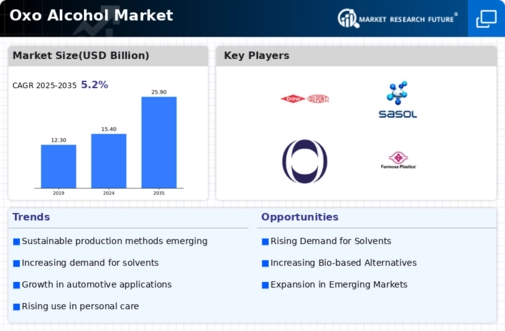Top Industry Leaders in the Oxo Alcohol Market
 Oxo alcohols, a versatile class of organic compounds derived from synthesis gas and olefins, find themselves at the heart of a thriving, yet intricate, market. With applications spanning from plasticizers in construction to solvents in pharmaceuticals, understanding the competitive landscape in this arena is crucial. Here, we dive into the strategies, factors influencing market share, key industry news, and the latest developments impacting oxo alcohols, offering a comprehensive view of this dynamic market.
Oxo alcohols, a versatile class of organic compounds derived from synthesis gas and olefins, find themselves at the heart of a thriving, yet intricate, market. With applications spanning from plasticizers in construction to solvents in pharmaceuticals, understanding the competitive landscape in this arena is crucial. Here, we dive into the strategies, factors influencing market share, key industry news, and the latest developments impacting oxo alcohols, offering a comprehensive view of this dynamic market.
Strategies Shaping the Arena:
-
Innovation and Diversification: Leading players like BASF, INEOS, and Oxea are investing heavily in R&D, developing novel oxo alcohol derivatives and exploring sustainable production methods like bio-based feedstocks. This focus on innovation helps cater to diverse end-user requirements and secure a competitive edge. -
Mergers and Acquisitions: As market leaders seek to consolidate their positions, strategic acquisitions have become a prominent trend. The 2023 acquisition of Vertellus Specialties by Eastman Chemical Company and the ongoing talks between Celanese and Exxon Mobil for their oxo alcohol businesses are examples of this consolidation wave. -
Geographic Expansion: Emerging markets in Asia, particularly China and India, present immense growth potential. Companies are establishing new production facilities in these regions to capitalize on the rising demand for oxo alcohols, particularly in construction and consumer goods sectors. -
Sustainability Focus: With increasing environmental concerns, sustainability initiatives are gaining traction. The development of bio-based oxo alcohols and energy-efficient production processes are becoming crucial differentiators, attracting environmentally conscious customers and investors.
Factors Dictating Market Share:
-
Feedstock Availability and Cost: The price and availability of olefins and synthesis gas significantly impact production costs. Companies with a secure and cost-effective feedstock supply chain hold a significant advantage. -
Technological Prowess: The ability to optimize production processes, develop new derivatives, and adapt to changing regulations are crucial for success. Continuous advancements in catalyst technology and process efficiency play a key role in gaining market share. -
Regional Demand Dynamics: Understanding the specific needs and growth trends in different regions allows companies to tailor their product offerings and distribution channels effectively. Asia's booming construction and consumer goods sectors present a significant opportunity, while mature markets in Europe and North America require a focus on specialty applications and high-performance grades. -
Regulatory Landscape: Stringent environmental regulations in some regions can significantly impact production costs and market dynamics. Companies with compliant and sustainable production processes gain a competitive edge.
Key Companies in the Oxo Alcohol market include
- DowDuPont (US)
- BASF SE (Germany)
- ExxonMobil Corporation (US)
- Eastman Chemical Company (US)
- Sasol (South Africa)
- Grupa Azoty ZAK SA (Poland)
- Ineos (UK)
- Formosa Plastics Corporation (Taiwan)
- China Petrochemical Corporation (China)
Recent Developments:
-
July 2023: Rising inflation and supply chain disruptions lead to a temporary dip in demand for oxo alcohols in Europe. -
August 2023: Increased construction activity in China boosts demand for plasticizer-grade oxo alcohols. -
September 2023: Hurricane Ian disrupts oxo alcohol production in the US, leading to a short-term price increase. -
October 2023: New bio-based oxo alcohol plant commences operation in India, attracting interest from eco-conscious buyers. -
November 2023: Soft demand across industries like automotive and appliance manufacturing continues to dampen the European oxo alcohol market. -
December 2023: Holiday season shopping contributes to a slight uptick in demand for oxo alcohol-based consumer goods such as paints and coatings.









